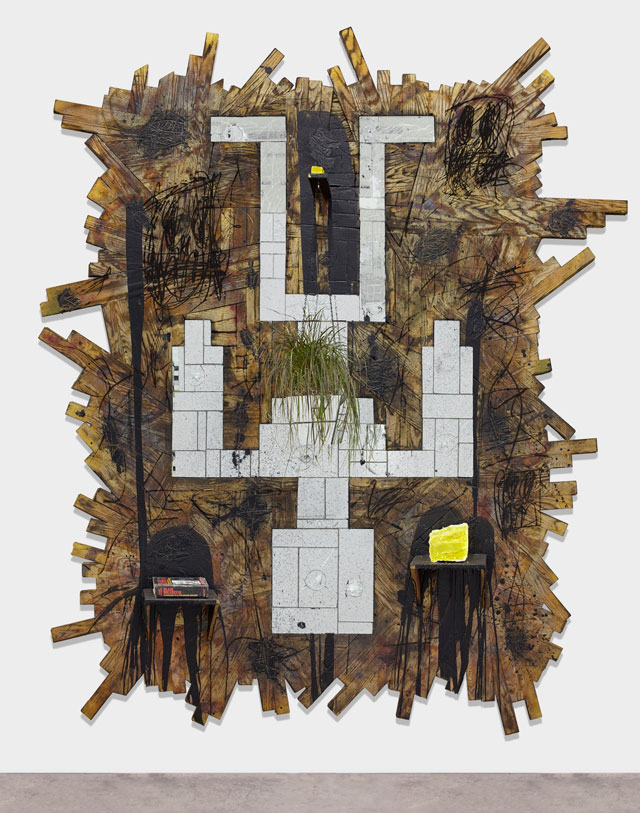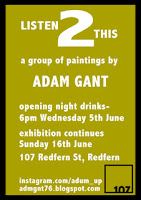Rashid Johnson was born in Chicago in 1977 and his art making spans across painting, photography, sculpture and installation. He has created many styles of work that have employed materials that symbolise the artists cultural upbringing and the portrayal of an African American experience. Johnston's work looks at the contradictions of his experience growing up in a middle class family to the projected view of the African American identity in hip hop, television and the media.
Johnson's mother is an African history professor and growing up around the objects that she studied and lectured on has enabled him to create a dialogue around how they come to represent culture in Africa and America. Objects such as books, plants, black soap, shea butter, oyster shells, animal skins, red oak flooring and LP records have made their way into his artwork as a way for him to connect their symbolism as cultural factors to his expression as an artist.
 |
| 'The Longest Dream' 2014 |
His early work as a photographer inspired him as a creative picture maker and the composition of much of his work uses the format of the grid to boldly present an image or object.
 |
| Installation of exhibition 'Hail We Now Sing Joy' at Kemper Museum of Contemporary Art |
|
In 2001 Johnson was included in the group exhibition Freestyle at the Studio Museum in Harlem, this exhibition was curated by Thelma Golden, who had been exploring her theme of post-black art, the controversial term which she and artist Glenn Ligon coined to describe the artists of the post-civil rights generation whose work no longer should be defined in terms of 'race'.
Johnson's themes around this time included concepts of identity that draws upon African American History and was explored through his selection of objects and symbols. In 2002 he choose the title 'Manumission Papers' that referenced the documents free slaves had to carry to prove their freedom.
In these photographs geometrical shapes arranged as grids, church windows and boats are outlined with only feet, hands or elbows. With each part of the body cut off from the whole the identity becomes anonymous, this could also be interpreted as the artist using the metaphor of racial identity for individuals becoming fractured and disconnected by cultural stereotyping.
 |
| 'Manumission Papers' 2002 |
With his series '
The New Negro Escapist Social and Athletic Club' the artist created the characters who are be poised to understand their own agency through the exploration of texts and culture but at the same time feel the need to escape it all. Johnson references the musician Sun Ra escaping the world that he saw full of flawed species and proclaiming to be born an Angel, 100 years ago in Saturn. The background of Sun Ra before he described himself this way is of a talented young reader of books and who had the ability to site read music at a young age. Striving to be an independent spirit through the rejection to what was outside his head sometimes had consequences like when he became an early conscientious objector to the WW2 draft and sent to prison.
 |
| 'The New Negro Escapist Social and Athletic Club' 2009 |
|
By exploring the works of intellectual and cultural figures of Art History and music, like Eldrige Cleaver, Bruce Conner, Joseph Beuys, Kasimir Malevich, Parliament Funkadelic and Sun Ra; Johnson is using the knowledge of their identity and individuality as a way of understanding his role as an artist as it fluctuates between studies of identity and areas of mysticism and cosmology.
 |
|
|
Johnson's work outside photography has seen a jump in style with an emphasis on the juxtapositions of materials as drawing and installation have been deployed to expand his ideas. The portraits in the series 'Anxious Men' stand out with immediate effect with each face roughly shaped using a waxy mixture with the facial features energetically scratched into them, the combination of how they are all uniformly placed within a grid and the stark monochrome colour of the black soap and wax material on a white tile make them compelling images. The paintings show individual faces or crowds of faces suggesting the prejudices that stereotype one person effects the whole group.
The black soap used in Anxious Men is a material used for cleansing and familiar to the artist since a child when he saw it sold in small tubs, the material took on a different meaning during a visit to Ghana where it was used on the bodies of warriors as a shield to protect themselves. Like shea butter it is medicinal and promote the power of healing. Johnson uses these motifs as a way of forming a complex relationship to Africa and a promotion of the self over racial stereotyping.
 |
| Anxious Men installation- Drawing Center, SoHo 2015 |
Johnson describes painting them using cosmic slop, a reference to the 1973 Funkadelic album and song and the name of a dance move which the artist connected to his movements and actions while painting, how the paint clumps together or splatters free from the image makes the portraits bristle with a nervous energy even after they've been flattened and had cartoonist features gauged out of the shapes. The reductionist method in these portraits is used by the artist to demonstrate how cultural stereotypes have had an effect of limiting the identity of black men to frightening or comical.
Johnson explored this idea when he used paintings of the 'Anxious Men' in his installation at the Drawing Center in SoHo in 2015 along with playing Melvin Van Peeble's "Love, That's America" a song he wrote for his 1970 film Watermelon Man, about a bigoted white salesmen who wakes up one day as a black man, the film show's the racism in suburbia and the workplace but does so for comic effects with the movie tagline being 'it won't happen to you so you can laugh'.

Another component in this installation is the the sleek and stylish design of wallpaper that shows the reverse of the anxious men, even as those paintings interrupt the mesmerizing pattern. The figure in the picture looks confident and relaxed in his taekwondo uniform and is surrounded by the books and electrical equipment that have developed his identity. The photo is of the artists father taken the year his son was born and the family biography shown through identity and collected possessions moves Johnson away from stereotyping to tell Johnson's story.
 |
| 'Antoine's Organ' 2016 |
In 2016 Johnson installed a collection of his pieces at Hauser and Wirth in New York under the banner of 'Fly Away' named after the 1929 gospel song 'I'll Fly Away'. A stunning piece of the show is 'Antoine's Organ' that included a performance each day by Antoine Black on a piano housed within the large grid structure which has been filled by books, video screens, mounds of shea butter and live plants in hand built pots made and painted by Johnson.
 |
| Deatail of 'Antoine's Organ' |
.jpg) |
| 'Untitled Escape Collage' 2016 |
Photo's of plants become a symbol of freedom and an escape away from the city in Johnson's Escapist Collages. They can lift the viewers spirits and there is a loosening of colour in the artist's pallet. In his other works each colour has represented an object, for example yellow represented shea butter, black is black soap, brown is wood and green is plants. In these works coloured tiles, coloured spray paint and solarizing colours are included as well as typical working methods of the artist such as the 'cosmic slop' and grid arrangement.
 |
| 'Flying Man' 2016 |
Another symbol from the exhibition was 'Falling Man' that was created in different ways with a combination of Johnson's recognisable objects being packed around the pixel like stick figure built out of mirrors. The artist places objects onto shelves for presentation like they would be in homes, like books, or to elevate their importance of them, like shea butter.






 Another component in this installation is the the sleek and stylish design of wallpaper that shows the reverse of the anxious men, even as those paintings interrupt the mesmerizing pattern. The figure in the picture looks confident and relaxed in his taekwondo uniform and is surrounded by the books and electrical equipment that have developed his identity. The photo is of the artists father taken the year his son was born and the family biography shown through identity and collected possessions moves Johnson away from stereotyping to tell Johnson's story.
Another component in this installation is the the sleek and stylish design of wallpaper that shows the reverse of the anxious men, even as those paintings interrupt the mesmerizing pattern. The figure in the picture looks confident and relaxed in his taekwondo uniform and is surrounded by the books and electrical equipment that have developed his identity. The photo is of the artists father taken the year his son was born and the family biography shown through identity and collected possessions moves Johnson away from stereotyping to tell Johnson's story.

.jpg)






Comments
Post a Comment